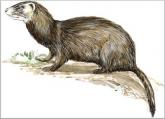Polecat - Mustela putorius
Dark brown coat with white parts on the nose, between the eyes and ears. The dark outer hairs are sparse so that the yellowish underskin is visible, giving a less uniform colour to the animal than the other Martens.
It can easily be mistaken for the more common weasel, but from which it differs for its smaller size, darker colour and absence of throat mark.
It mostly lives on the plains and in woodlands but often occurs along river banks and in marshlands. The Polecat is mainly terrestrial and rarely climbs plants or swims. It is active by night and solitary: like all Mustelidae it is very shy and it is difficult to tell its whereabouts.
It has two scent glands which eject a particularly acrid substance it uses to mark its territory but which it also secretes when alarmed. It breeds once a year and gives birth to 5-10 young that are born in May-June. It feeds on rodents, rabbits, frogs, birds, worms, insects and probably carrion too.
The Polecat is present throughout all peninsular Italy but not on the Islands, although its true distribution is uncertain. Listed species in Article 2 of Law no. 157 of 11/02/1992.
Listed species with special protection under Law no. 157/1992 (rules governing the protection of homoeothermic wild animals and hunted species).




